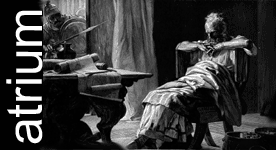From the Yorkshire Post:
ANOTHER headless skeleton discovered in York is among a series of gruesome archaeological finds which could hold the key to unlocking secrets behind Roman burial rituals.
The latest discovery of human remains by archaeologists follows in the wake of another headless skeleton found shackled in a grave and a Roman mummy which was also unearthed in The Mount area of the city.
A total of 57 bodies – 50 adults and seven children – and 14 sets of cremated remains have been found during excavations, most by the York Archaeological Trust at a site in Driffield Terrace.
Archaeologists are now confident the bodies will provide perhaps the clearest indication yet on the Roman attitude to death.
It is thought the Romans could have beheaded corpses to release the human spirit, which they believed was contained in the head.
Excavations are continuing at the site which is earmarked for a new housing development and falls in the heart of one of York's most important Roman cemeteries.
Mike Griffiths, a consultant archaeologist for the developers, Shepherd Homes, discovered the 57th body – the first his team has unearthed.
"The latest finds could prove to be very important," he said.
"The last time anything was found on a similar scale was in the Victorian times, but the finds were often not recorded correctly and have been lost through the passage of time.
"Techniques have advanced a great deal since then, and we have far superior scientific analysis to examine the finds as well.
"These skeletons could provide us with the clearest indication yet as to how the Romans treated death and the passage to the afterlife."
Some Roman customs meant that bodies were buried outside the city, often at the roadside.
Archaeologists had expected to discover human remains at The Mount as it lies on the main Roman road between York and Tadcaster, but they have been taken aback by the number of beheaded skeletons uncovered.
The latest, which was discovered at the end of last week, has proved to be a departure from the previous remains.
Its head had been brutally hacked off and three or four vertebrae are missing. Other remains have had the head removed in a far more precise manner, suggesting the person was already dead.
The latest find indicates the man, who was aged in his late 30s or early 40s, could have been alive when he was beheaded.
Two deep puncture wounds were also made to his neck, with evidence of the weapon used causing damage to the remains of the spinal bone.
The latest remains are being stored in York for when paleopathologist Malin Holst returns from a trip to Germany. She will then analyse the bones to establish more about the man's death.
